Welcome to our informative blog on high-density date palm plantations! This article will explore the fascinating world of date palm cultivation, focusing on key aspects such as spacing, number of plants per acre, techniques employed, costs involved, and expected yields. Whether you’re a seasoned farmer or just curious about this unique agricultural practice, we’ve got you covered. Join us as we delve into maximizing productivity and efficiency in date palm plantations. Let’s dive right in and discover the secrets behind this ancient and lucrative crop.
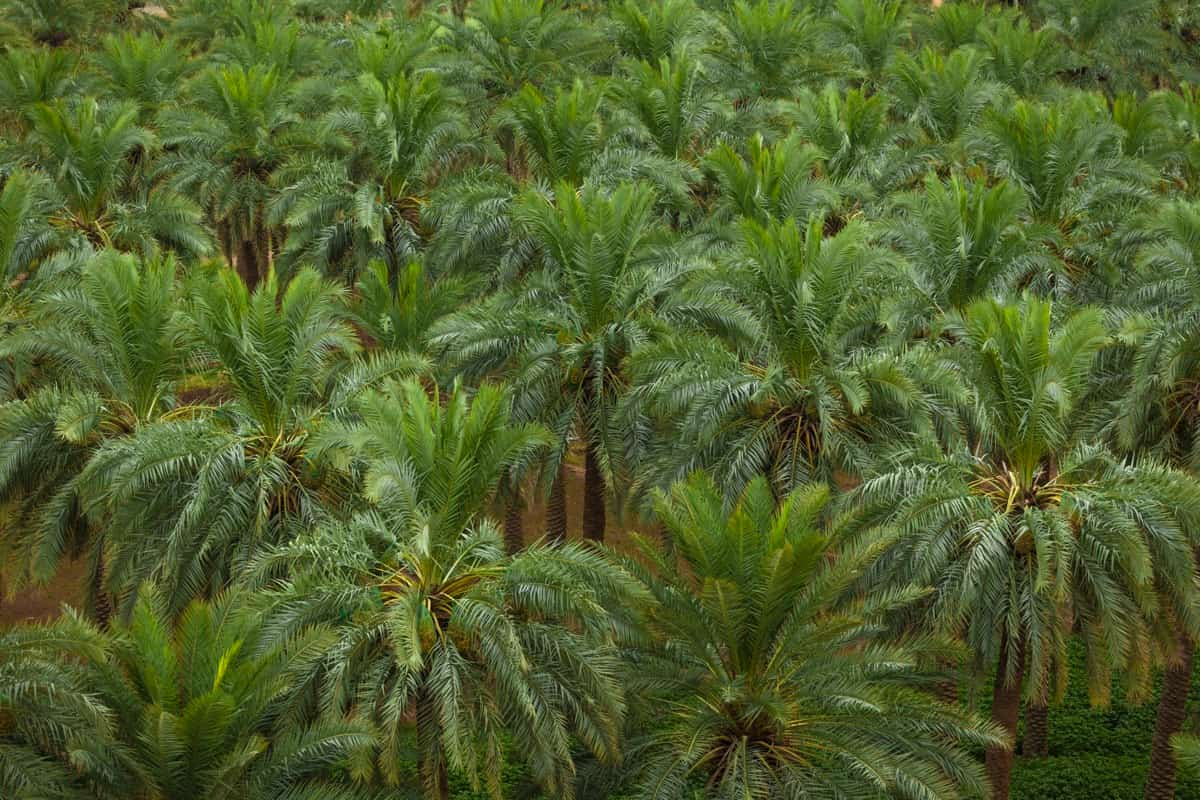
What is High-Density Date Palm Plantation?
High-density date palm plantation refers to a modern approach to cultivating date palm trees, where the plants are grown closer to each other than traditional methods. Typically, in high-density plantations, the spacing between trees ranges from 5 to 6 meters (16 to 20 feet). This close spacing allows for a higher number of trees per acre, resulting in increased yields and efficient land utilization. Farmers adopting this technique can expect significant productivity improvements and profitability of their date palm plantations.
Benefits of High-Density Date Palm Plantation
High-density date palm plantations offer a range of benefits that make them a highly attractive choice for farmers. By planting date palms in a dense arrangement, farmers can maximize land utilization and achieve higher yields per acre. Research indicates that high-density plantations can produce up to 30% more fruit than traditional spacing methods.
Additionally, the proximity of trees facilitates efficient pollination, resulting in improved fruit quality and uniformity. Moreover, high-density plantations provide better disease and pest management due to increased airflow and sunlight penetration. These advantages contribute to higher profitability and sustainability in date palm cultivation.
High-Density Date Palm Plantation Techniques
One such technique is dwarf or semi-dwarf cultivars, which have smaller canopy sizes and allow for closer tree spacing. Typical spacing in high-density plantations ranges from 5.5 to 6.5 meters. Farmers often employ drip irrigation systems to ensure efficient water distribution and minimize wastage. Regular pruning and training methods, such as the open-vase or modified central leader systems, are implemented to control the tree’s height and facilitate easier harvesting.
In case you missed it: Top 16 Steps to Boost Oil Palm Yield: How to Increase Production, Size, And Quality
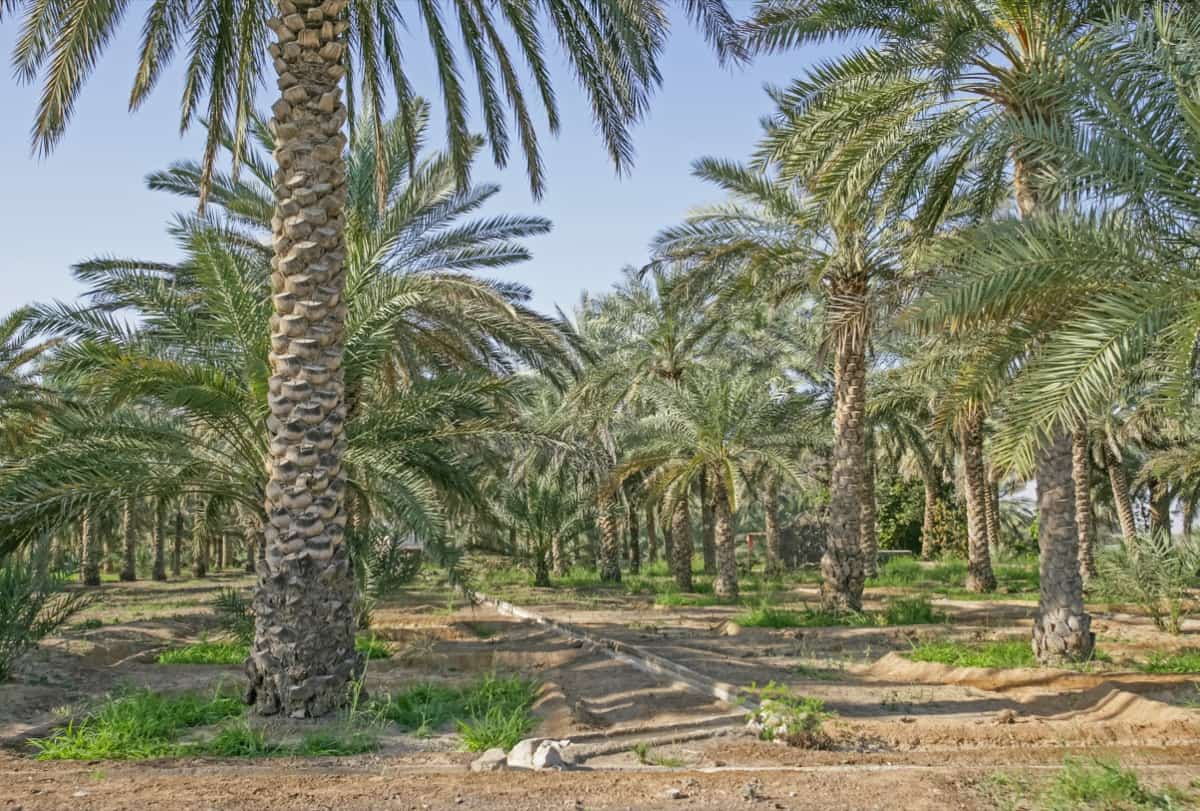
Increasing Yield in High-Density Date Palm Plantation
Farmers can remove dead or unproductive fronds by implementing proper pruning, allowing the palm to allocate more energy toward fruit production in high density date palms. Additionally, strategic thinning of the fruit bunches promotes better air circulation, reducing the risk of disease and enhancing fruit quality.
Another method is the application of balanced fertilizers to meet the specific nutritional requirements of date palms. Furthermore, precise irrigation management, utilizing techniques such as drip irrigation, ensures optimal water distribution, preventing water stress and maximizing yield potential.
Sustainable and Best Practices for High-Density Date Palm Plantation
Soil: Date palms can thrive in various soil types, but well-drained, deep sandy loam soil with a pH range of 7-8 is ideal. Avoid soils with a hard pan within 2 meters of the surface. While saline and alkaline soils are suitable, the yield may be lower.
Land Preparation: Thoroughly plow the land 2-3 times and ensure a fine tilth. In summer, dig 1m x 1m x 1m pits, leaving them open for two weeks, then fill them with well-decomposed cow dung, fertile soil, and recommended pesticides.
Sowing: Sowing is typically done between February and March or August and September. For transplantation, dig 1m x 1m x 1m pits at a distance of 6m or 8m in a square system.
Seed: Date palm propagation is mainly done using suckers rather than seeds. Select offshoots from a mother plant, preferably in the 4th or 5th year. Prepare the suckers by adding a mixture of decomposed cow dung, sand, and sawdust around them. Remove older leaves during separation.
Intercrops: During the initial 4-5 years, intercropping with vegetables like guar gum, rice, chili, peas, and brinjal is possible.
Fertilizer: Apply organic manure (FYM) at 10-15kg for young plants and 30-40kg per tree for mature plants. Urea is applied in two equal splits, with the first dose before flowering and the second after the fruit set.
Weed Control: Maintain a clean and weed-free field. Perform weeding or hoeing as needed, and consider using mulch for effective weed control.
Irrigation: During summer, irrigate every 10-15 days, and during winter, irrigate every 30-40 days. Irrigation is crucial after spathe emergence and at regular intervals after the fruit set.
Plant Protection: Protect the plants from pests such as termites, lesser-date moths, and birds using appropriate measures and sprays. Control diseases like Graphiola leaf spot and Alternaria leaf blight with recommended fungicides.
Harvesting: Harvest the fruits in three stages: Khalal or Doka stage (fresh fruits), soft or ripen stage (pind or Tamar), and dry stage (chuhhara). Complete harvesting before the monsoon season.
Post-Harvest: After harvesting at the Doka stage, wash the fruits with clean water. For chuhhara production, dry the fruits either in the sun or in a dryer at 40-45°C for 80 to 120 hours.
High-Density Date Palm Plantation Spacing
- Time of sowing: Sow date palm seeds or transplant suckers between February and March or August to September.
- Spacing: For transplantation, dig pits measuring 1m x 1m x 1m at a distance of 5m or 6m, or 8m in a square system. One acre can accommodate around 100-120 with 6m x 6m.
- Sowing Depth: When transplanting, ensure the pits are 1m x 1m x 1m in size.
- Method of sowing: Transplant the suckers into the main field for cultivation.
In case you missed it: Top 17 Steps to Boost Date Palm Yield: How to Increase Production, Quality, and Size
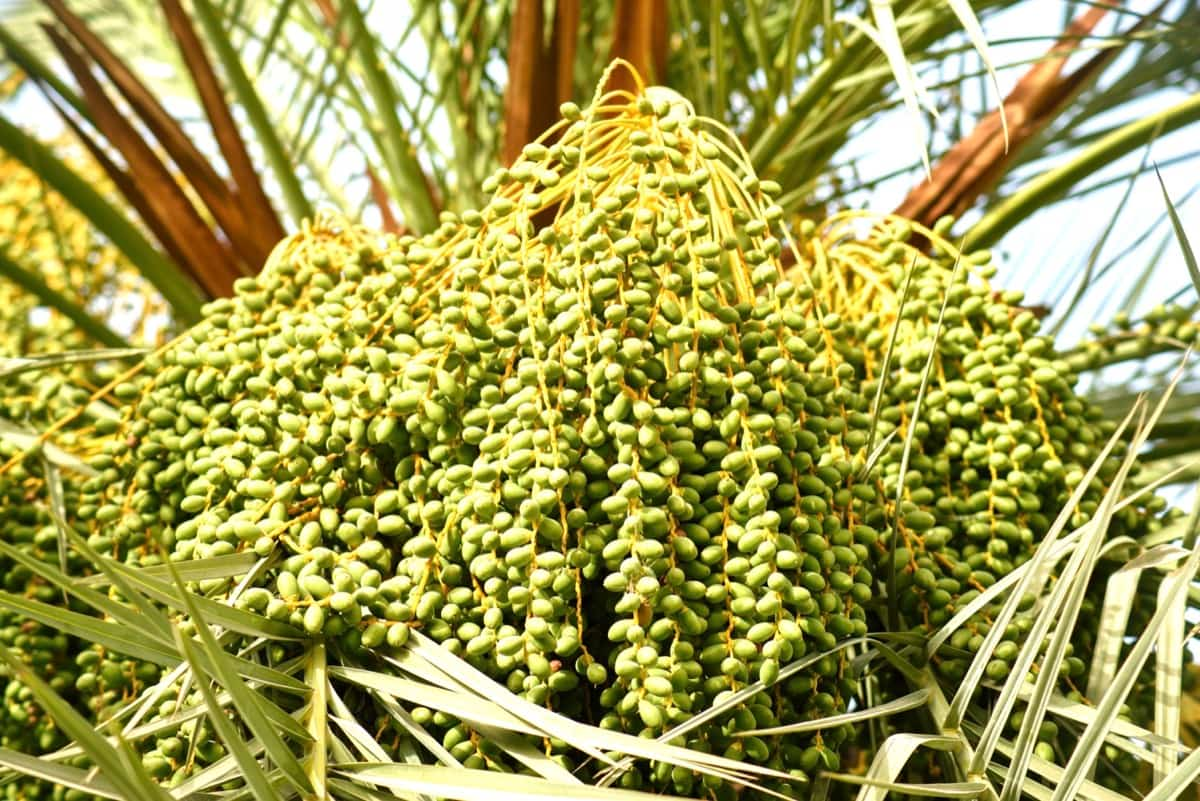
High-Density Date Palm Plantation Varieties
- Medjool: Known for its large, soft, and sweet fruits, Medjool is a popular date variety with a caramel-like flavor.
- Barhi: Barhi dates are small, round, soft, and creamy. They are often enjoyed when they are still partially ripe and crunchy.
- Deglet Noor: Deglet Noor dates are semi-dry and have a firm texture. They are widely used in cooking and baking due to their pleasant, slightly nutty taste.
- Zahidi: Zahidi dates are medium-sized and have a firm and chewy texture. They are commonly used for snacking and as an ingredient in various dishes.
- Khadrawy: Khadrawy dates are small to medium-sized and have a soft and moist texture. They are highly prized for their rich and honey-like flavor.
High-Density Date Palm Plantation Irrigation
Immediate watering after planting is essential for establishment. Date palms prefer consistent soil moisture, but waterlogging should be avoided. During the monsoon season, irrigation is usually optional due to sufficient rainfall. Flooding should be addressed promptly by draining excess water. 5-6 irrigations per year are generally sufficient in areas with a high water table.
Once offshoots appear, irrigation frequency can be reduced, but monitoring soil moisture is important. Mulching with dried leaves and grass helps retain soil moisture, especially in arid climates. Summer irrigation occurs every 10-15 days, while winter intervals extend to 30-40 days. Pre-flowering and post-fruit set irrigations are crucial stages to consider.
High-Density Date Palm Plantation Pruning Methods
Pruning involves removing dead or diseased fronds and controlling the tree’s size and shape. Two commonly used methods are manual pruning and mechanical pruning. Manual pruning entails skilled laborers using sharp tools to remove fronds selectively. It requires precision and expertise to avoid damage to the tree.
In case you missed it: Earning 7 Lakh Per Year from Date Palms: A Date Palm Farmer Success Story
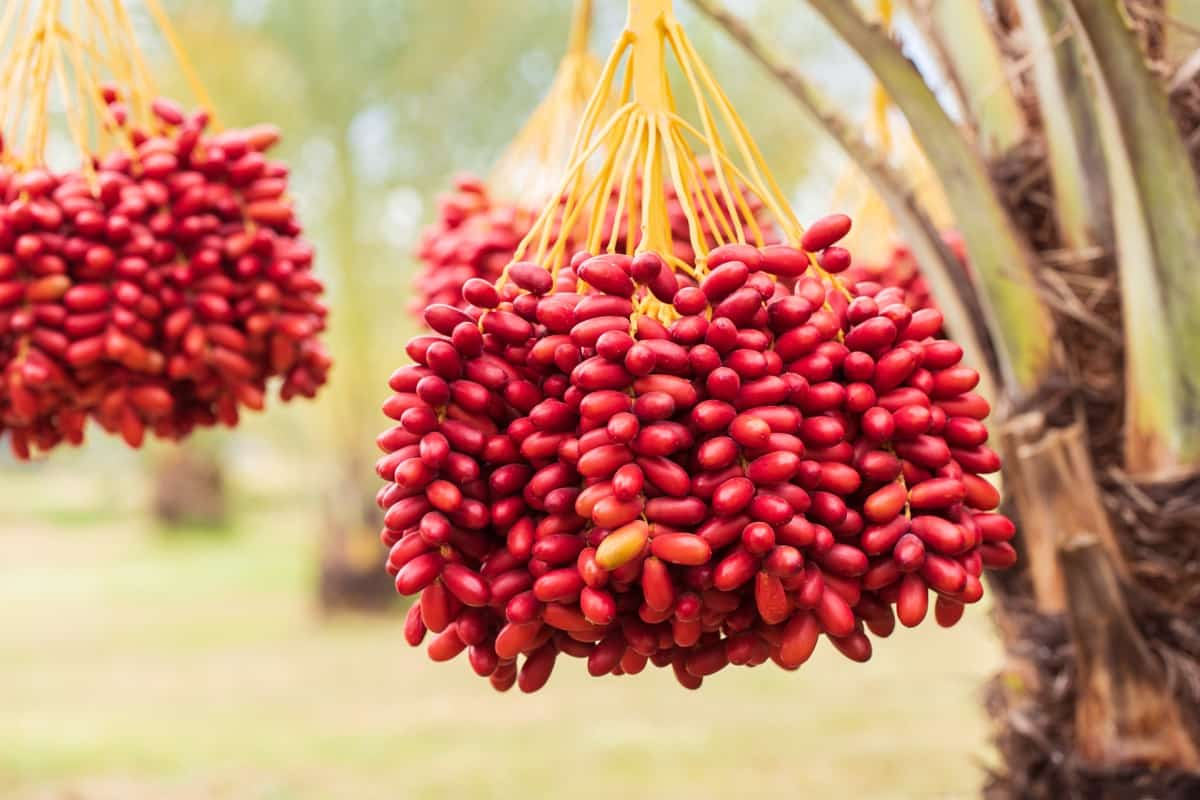
On the other hand, mechanical pruning involves using specialized equipment, such as pruning machines, to remove fronds quickly and efficiently. Both methods have advantages and limitations, and the choice depends on factors such as plantation size, labor availability, and budget.
Optimal Fertilization for High-Density Date Palm Plantation
To achieve optimal fertilization in high-density date palm plantations, each tree requires 30-40 kg of farmyard manure (FYM) and 200 g each of Nitrogen, Phosphorus, and Potassium (NPK) for rainfed areas. Apply FYM at 10-15 kg for young plants and 30-40 kg for mature plants between September and October. Urea is applied at a rate of 4.4 kg from one-year-old plants to mature trees, divided into two equal splits.
The first dose is given before flowering, and the second half is applied after the fruit set in April. Each tree requires 50-60 kg of FYM and 200 g of NPK for irrigated areas. Apply the entire amount of FYM, half of N, and full doses of P and K in September-October. Apply the remaining half of N in January-February. Green manuring with rotting leguminous cover crops can be beneficial.
High-Density Date Palm Plantation Disease Control
- Graphiola leaf spot: This fungal disease occurs under humid conditions, leading to gray-colored spots on both sides of the leaves. To control it, apply a foliar spray of Copper Oxychloride at a rate of 3gm per liter of water or Mancozeb at 2gm per liter.
- Alternaria leaf blight: If you observe infestation, spray Mancozeb + Carbendazim at 2gm per liter of water. Repeat the spray after a 15-day interval.
- Fruit rot: Rainfall or high humidity during the fruiting to maturity stage can cause fruit rot. Cover the bunches with paper during the early khalal stage to prevent this. Remove a few fruit strands from the center of the bunch to improve ventilation and aid in drying. If infestation occurs, apply a spray of Mancozeb + Carbendazim at a rate of 2gm per liter of water.
In case you missed it: Best Fertilizer for Date Palms: Organic, Compost, NPK, When and How to Apply

Managing Pests in High-Density Date Palm Plantations
- Black-headed Caterpillar
- Red Weevil/Indian Palm Weevil
- Rhinoceros Beetle/Black Palm Beetle
- Scale Insects: No information was provided.
- Birds: Cover the bunches with thin wire netting when the crop reaches the Doka stage to protect the fruits from bird damage.
- Termites: These pests attack the roots of date palm plants. Apply Chlorpyrifos through drip irrigation to control termites. Mix 800ml of Chlorpyrifos in 150 liters of water and apply it to the roots of the plants.
- Lesser Date Moth: As a preventive measure, spray Deltamethrin at a rate of 2ml per liter of water with a 15-day interval. The first spray should be applied at the fruit-bearing stage.
- White/Red Scale: Remove scale-infested branches or leaves and destroy them away from the field. If infestation is observed, spray Acetamiprid at 60gm per 100 liters of water or Imidacloprid at 60ml per 100 liters of water.
High-Density Date Palm Plantation Harvesting Tips
Harvesting tips for high-density date palm plantations are important to ensure a successful harvest and maintain fruit quality. Date palm trees are typically ready for their first harvest four to five years after plantation. The fruits are harvested at three stages: Khalal or doka stage (fresh fruits), soft or ripen stage (pind or tamar), and dry stage (chuhhara).
It is recommended to complete the harvesting process before the start of the monsoon season to avoid potential damage from excessive moisture. Post-harvest, washing the fruits with clean water after harvesting them at the doka stage is advisable. If chuhhara (dry date) production is desired, the fruits are dried under the sun or in a dryer at 40-45°C temperature for 80 to 120 hours. These practices contribute to maintaining the quality and value of the harvested date palm fruits.
High-Density Date Palm Plantation Cost Analysis (1 Acre Basis)
Date palms take 3-4 years to reach their first harvest, producing around 20-25 kg per tree. Full growth of date palm trees takes 7-8 years, with a potential yield of 150-200 kg of dates per tree. Date farming is considered a profitable venture in India, with high demand and low production leading to higher prices. Rajasthan, Gujarat, Kerala, and Karnataka are known for date palm cultivation.
On 1 acre of land, approximately 85-120 date palm trees can be planted. Assuming each tree produces an average of 150 kg of dates, the total yield would be around 9,000-12,000 kg. With prices ranging from Rs 150-200 per kg, the potential revenue could be Rs 16,20,000-20,00,000 (USD 30,000) per year. The initial investment for planting 85 trees is approximately Rs 4,20,000-5,90,000 (USD 6,000).
In case you missed it: High-Density Dragon Fruit Plantation: Spacing, Plants Per Acre, Techniques, Cost, and Yield
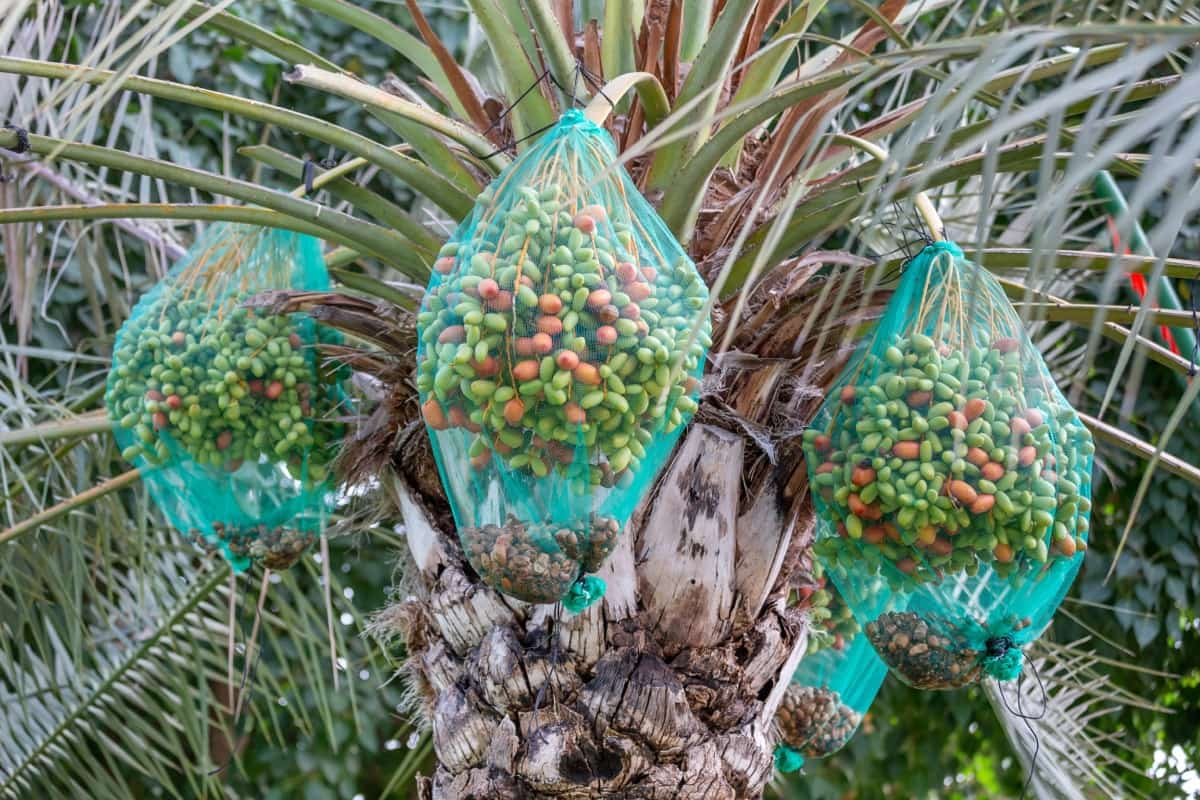
Intercropping can be done with other crops to generate additional income. Organic fertilizers like cow dung manure are recommended. Pollination occurs naturally through wind, bees, and insects. Proper spacing between date palm trees is important for optimal fruit production, with an ideal distance of 20-25 feet. Date palm trees can produce fruits for over 100 years, making it a long-term profitable business venture.
Conclusion
High-density date palm plantation, with a spacing of 6×6 meters, allows for 85-100 plants per acre. Techniques like drip irrigation and controlled pruning enhance yield. Initial setup costs are higher, but the increased yield compensates for it, resulting in better profitability.
- How to Build a Low-budget Goat Shed: Cheap Ideas and Tips
- Goat Farming Training Programs in India: A Beginner’s Guide
- Types of Pesticides Used in Agriculture: A Beginner’s Guide
- Economical Aquaculture: A Guide to Low-Budget Fish Farming
- 15 Common Planting Errors That Can Doom Your Fruit Trees
- How to Make Houseplants Bushy: Effective Tips and Ideas
- Innovative Strategies for Boosting Coconut Pollination and Yield
- Pollination Strategies for Maximum Pumpkin Yield
- The Complete Guide to Chicken Fattening: Strategies for Maximum Growth
- Natural Solutions for Tulip Problems: 100% Effective Remedies for Leaf and Bulb-Related Issues
- Revolutionizing Citrus Preservation: Towards a Healthier, Greener Future
- Natural Solutions for Peony Leaf and Flower Problems: 100% Effective Remedies
- Maximizing Profits with Avocado Contract Farming in India: A Comprehensive Guide
- Natural Solutions for Hydrangea Problems: 100% Effective Remedies for Leaf and Flowers
- The Ultimate Guide to Choosing the Perfect Foliage Friend: Bringing Life Indoors
- From Sunlight to Sustainability: 15 Ways to Use Solar Technology in Agriculture
- The Ultimate Guide to Dong Tao Chicken: Exploring from History to Raising
- The Eco-Friendly Makeover: How to Convert Your Unused Swimming Pool into a Fish Pond
- Mastering the Art of Delaware Chicken Farming: Essentials for Healthy Backyard Flocks
- 20 Best Homemade Fertilizers for Money Plant: DIY Recipes and Application Methods
- How to Craft a Comprehensive Free-Range Chicken Farming Business Plan
- Brighten Your Flock: Raising Easter Egger Chickens for Beauty and Bounty
- How to Optimize Your Poultry Egg Farm Business Plan with These Strategies
- Subsidy for Spirulina Cultivation: How Indian Government Schemes Encouraging Spirulina Farmers
- Ultimate Guide to Raising Dominique Chickens: Breeding, Feeding, Egg-Production, and Care
- Mastering the Art of Raising Jersey Giant Chickens: Care, Feeding, and More
- Ultimate Guide to Raising Legbar Chickens: Breeding, Farming Practices, Diet, Egg-Production
- How to Raise Welsummer Chickens: A Comprehensive Guide for Beginners
- How to Protect Indoor Plants in Winter: A Comprehensive Guide
- Ultimate Guide to Grow Bag Gardening: Tips, Tricks, and Planting Ideas for Urban Gardeners
- Guide to Lotus Cultivation: How to Propagate, Plant, Grow, Care, Cost, and Profit
- Agriculture Drone Subsidy Scheme: Government Kisan Subsidy, License, and How to Apply Online
- Ultimate Guide to Raising Araucana Chickens: Breed Profile, Farming Economics, Diet, and Care
- Bringing Hydroponics to Classroom: Importance, Benefits of Learning for School Students
- Ultimate Guide to Raising Polish Chickens: Breed Profile, Farming Economics, Diet, and Care
- Ultimate Guide to Raising Australorp Chickens: Profile, Farming Economics, Egg Production, Diet, and Care